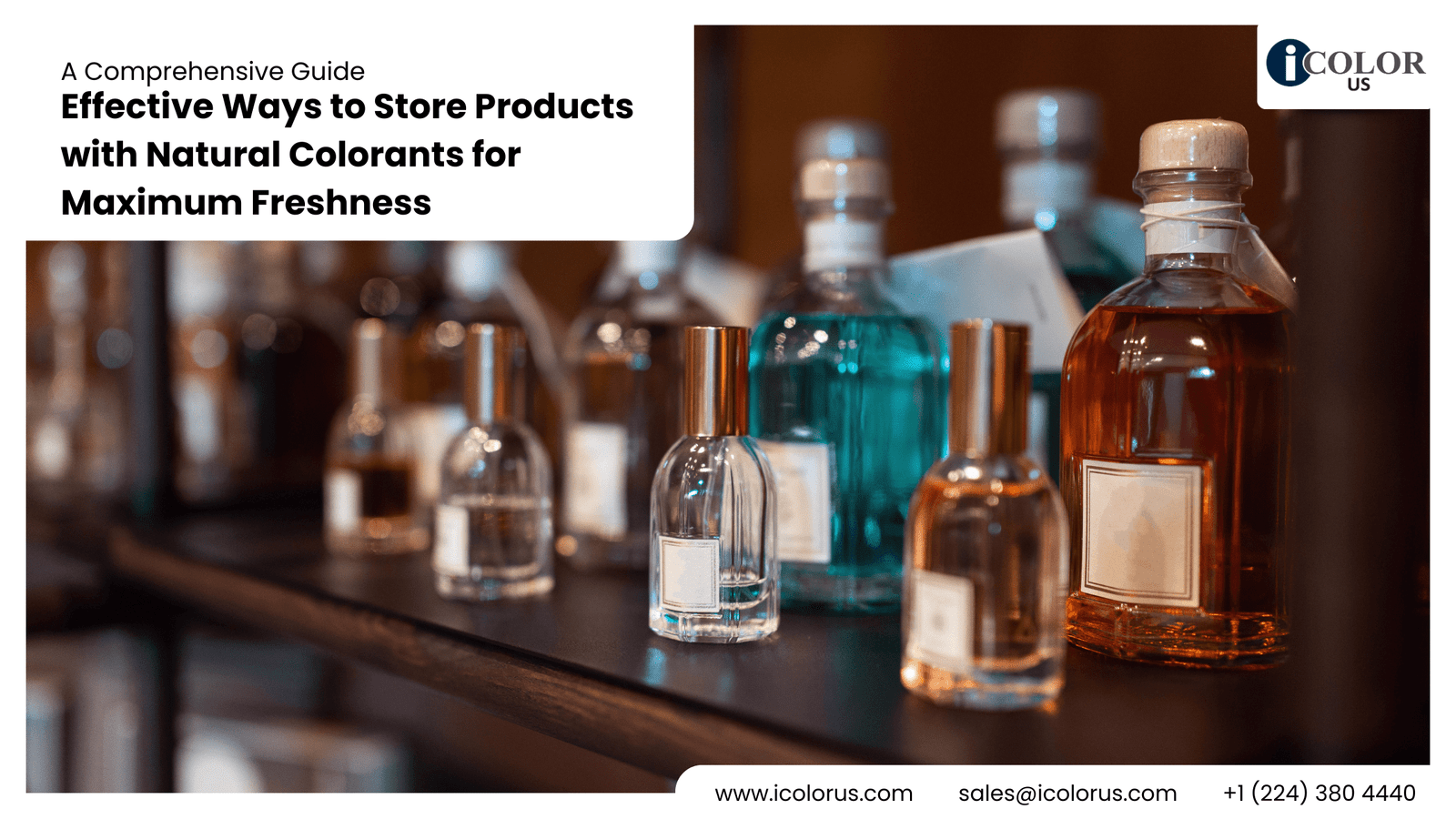Store Products with Natural Colorants – Outline
- Introduction
- Importance of natural colorants in products
- Overview of challenges in storing products with natural colorants
- Understanding Natural Colorants
- Definition and types
- Common sources of natural colorants
- Benefits of Natural Colorants
- Health benefits
- Environmental advantages
- Consumer preferences
- Challenges in Storing Natural Colorants
- Sensitivity to light
- Temperature fluctuations
- Oxidation issues
- Packaging Materials for Natural Colorants
- Types of packaging materials
- Advantages of each type
- Best practices for choosing packaging
- Temperature Control
- Ideal storage temperatures
- Effects of temperature on natural colorants
- Equipment for temperature control
- Light Protection
- Impact of light on natural colorants
- Strategies for light protection
- Examples of effective light-protective packaging
- Humidity Control
- Importance of humidity control
- Methods to maintain optimal humidity
- Impact of humidity on product stability
- Oxygen Exposure
- Effects of oxygen on natural colorants
- Techniques to minimize oxygen exposure
- Use of antioxidants
- Storage Containers
- Types of storage containers
- Pros and cons of different materials
- Recommendations for best storage containers
- Labeling and Rotation
- Importance of proper labeling
- FIFO (First In, First Out) method
- Monitoring expiration dates
- Regulatory Considerations
- Regulatory guidelines for storing natural colorants
- Compliance with health and safety standards
- Documentation and record-keeping
- Case Studies
- Examples of successful storage practices
- Lessons learned from industry leaders
- Common Mistakes to Avoid
- Frequent storage errors
- How to avoid these mistakes
- Tips for better storage practices
- Conclusion
- Summary of key points
- Final thoughts on best practices for storing products with natural colorants
- FAQs
- How long do natural colorants typically last?
- Can natural colorants be frozen for storage?
- What are the signs that a natural colorant has degraded?
- Are there specific containers recommended for different types of natural colorants?
- How can I ensure compliance with regulatory standards when storing natural colorants?
How to Store Products with Natural Colorants
Introduction
Natural colorants have become increasingly popular due to their health benefits and eco-friendly nature. However, storing products with these colorants poses unique challenges. This guide will walk you through the best practices for storing products with natural colorants to ensure they maintain their quality and effectiveness.
Understanding Natural Colorants
Definition and Types
Natural colorants are pigments derived from natural sources such as plants, minerals, and animals. Unlike synthetic dyes, these colorants are extracted using natural processes. Common types include:
- Plant-based colorants: Derived from fruits, vegetables, leaves, and roots (e.g., beetroot red, turmeric yellow).
- Mineral-based colorants: Sourced from naturally occurring minerals (e.g., iron oxides).
- Animal-based colorants: Extracted from insects and other animals (e.g., cochineal extract).
Common Sources of Natural Colorants
Some widely used natural colorants and their sources include:
- Anthocyanins: Found in berries, grapes, and red cabbage.
- Carotenoids: Present in carrots, pumpkins, and tomatoes.
- Chlorophyll: Sourced from leafy greens like spinach.
- Betalains: Found in beets and cactus fruit.
Benefits of Natural Colorants
Health Benefits
Natural colorants often come with health benefits due to their antioxidant properties and lack of harmful chemicals. For instance, anthocyanins have been linked to reduced inflammation and improved heart health.
Environmental Advantages
Using natural colorants reduces the environmental impact compared to synthetic dyes, which often involve harmful chemicals and pollutants.
Consumer Preferences
Consumers increasingly prefer natural ingredients, associating them with higher quality and safety. This trend boosts the demand for products with natural colorants.
Challenges in Storing Natural Colorants
Sensitivity to Light
Natural colorants are highly sensitive to light, which can cause them to degrade and lose their vibrancy.
Temperature Fluctuations
Exposure to varying temperatures can affect the stability of natural colorants, leading to changes in color and effectiveness.
Oxidation Issues
Oxygen exposure can cause natural colorants to oxidize, resulting in color changes and reduced shelf life.
Packaging Materials for Natural Colorants
Types of Packaging Materials
The right packaging can significantly impact the longevity of natural colorants. Some effective materials include:
- Glass: Provides excellent protection against oxygen and light.
- Plastic: Lightweight and versatile, but choose food-grade options.
- Metal: Offers good protection but can be reactive with some colorants.
- Composite Materials: Combines benefits of different materials for optimal protection.
Advantages of Each Type
- Glass: Non-reactive and impermeable.
- Plastic: Flexible and cost-effective.
- Metal: Durable and robust.
- Composite Materials: Customizable for specific needs.
Best Practices for Choosing Packaging
- Ensure packaging is airtight to minimize oxygen exposure.
- Use opaque or dark-colored materials to protect from light.
- Select materials that are non-reactive with the colorants.
Temperature Control
Ideal Storage Temperatures
Different colorants have varying optimal storage temperatures, but generally, a cool, stable environment is best.
Effects of Temperature on Natural Colorants
High temperatures can accelerate degradation, while freezing can cause crystallization and texture changes.
Equipment for Temperature Control
- Refrigerators: Ideal for keeping products cool.
- Climate-controlled storage units: Maintain consistent temperatures.
- Thermocouples: Monitor and control temperature fluctuations.
Light Protection
Impact of Light on Natural Colorants
Light exposure can cause photo-degradation, leading to color loss and chemical breakdown.
Strategies for Light Protection
- Store products in dark or opaque containers.
- Use UV-blocking packaging materials.
- Keep storage areas away from direct sunlight.
Examples of Effective Light-Protective Packaging
- Amber glass bottles: Block UV rays effectively.
- Opaque plastic containers: Prevent light penetration.
- Metal tins: Offer complete light protection.
Humidity Control
Importance of Humidity Control
High humidity can promote mold growth and affect the texture and stability of products with natural colorants.
Methods to Maintain Optimal Humidity
- Use dehumidifiers in storage areas.
- Store in airtight containers with moisture absorbers.
- Monitor humidity levels regularly.
Impact of Humidity on Product Stability
Excessive moisture can cause clumping, color changes, and reduced effectiveness of natural colorants.
Oxygen Exposure
Effects of Oxygen on Natural Colorants
Oxygen can lead to oxidation, causing discoloration and spoilage.
Techniques to Minimize Oxygen Exposure
- Use vacuum sealing or oxygen absorbers.
- Store in airtight containers.
- Fill containers completely to minimize air space.
Use of Antioxidants
Adding natural antioxidants like vitamin E can help protect colorants from oxidation.
Storage Containers
Types of Storage Containers
- Glass jars
- Plastic tubs
- Metal cans
- Vacuum-sealed bags
Pros and Cons of Different Materials
- Glass jars: Non-reactive but fragile.
- Plastic tubs: Lightweight but can be permeable.
- Metal cans: Durable but potentially reactive.
- Vacuum-sealed bags: Excellent for oxygen exclusion but less protective against light.
Recommendations for Best Storage Containers
Choose containers based on the specific needs of the colorant, considering factors like light sensitivity and oxygen exposure.
Labeling and Rotation
Importance of Proper Labeling
Clearly labeled products help track expiration dates and ensure proper usage.
FIFO (First In, First Out) Method
Use older products first to minimize waste and ensure freshness.
Monitoring Expiration Dates
Regularly check and rotate stock to use products before they expire.
Regulatory Considerations
Regulatory Guidelines for Storing Natural Colorants
Ensure compliance with local and international regulations regarding food safety and storage.
Compliance with Health and Safety Standards
Follow guidelines from bodies like the FDA or EFSA to ensure products remain safe and effective.
Documentation and Record-Keeping
Maintain records of storage conditions, batch numbers, and expiration dates to ensure traceability and compliance.
Case Studies
Examples of Successful Storage Practices
Learn from industry leaders who have effectively stored products with natural colorants.
Lessons Learned from Industry Leaders
Implement best practices based on real-world experiences and avoid common pitfalls.
Common Mistakes to Avoid
Frequent Storage Errors
- Improper labeling
- Exposure to light and oxygen
- Temperature fluctuations
How to Avoid These Mistakes
- Invest in quality packaging and storage solutions.
- Train staff on proper handling and storage techniques.
- Regularly review and update storage protocols.
Tips for Better Storage Practices
- Conduct regular audits of storage conditions.
- Use technology to monitor and control environmental factors.
- Stay informed about new developments in storage technologies.
Conclusion
Storing products with natural colorants requires careful consideration of factors like light, temperature, humidity, and oxygen exposure. By following the best practices outlined in this guide, you can ensure your products remain vibrant and effective for as long as possible.
FAQs
How long do natural colorants typically last?
The shelf life of natural colorants varies, but with proper storage, they can last from several months to a few years.
Can natural colorants be frozen for storage?
While freezing can extend shelf life, it may affect the texture and solubility of some colorants. It’s best to test freezing on a small batch first.
What are the signs that a natural colorant has degraded?
Common signs include fading color, off-odors, and changes in texture or consistency.
Are there specific containers recommended for different types of natural colorants?
Yes, choose containers based on the colorant’s sensitivity to light, oxygen, and moisture. Glass jars, vacuum-sealed bags, and opaque plastic containers are often recommended.
How can I ensure compliance with regulatory standards when storing natural colorants?
Stay updated with local and international regulations, maintain detailed records, and regularly audit your storage practices to ensure compliance.





